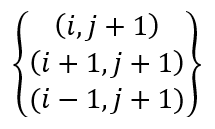Gold Mine Problem
Given a gold mine of n*m dimensions, each cell in this mine contains a positive integer which is the amount of gold in tons. Initially, the miner is at the first column but can be at any row. He can move only right or right up or right down from the current cell, i.e., the miner can move to the cell diagonally up towards the right or right or diagonally down towards the right. Find out the maximum amount of gold he can collect.
Input:
Matrix:
{{1,5,12},
{2,4,4},
{0,6,4}
{3,0,0}
}
Output:
18
Input:
Matrix:
{{1,3,1,5},
{2,2,4,1},
{5,0,2,3},
{0,6,11,2}
}
Output:
25
Explanation with example
So, the matrix is:

So, the miner starts from the first column (any row) and he has to reach the last row with maximum gold.
To make a note, the possible moves from a cell (i,j) is to either of,

Now, it seems apparently that greedy may work for the problem that is at the first column pick the cell with maximum value and then move to next best neighbouring cell.
If we follow the above greedy approach,
We would pick (3,0) as our starting cell since that contains maximum gold out of the first column. The next best move would be (2,1) and then to (2,2).
So, the total gold collected is = (3+6+4) = 13
Is this the global maximum? Do our local maximum choices lead to global maximum?
No, it's not the global maximum.
The global maximum path would be: (1,0) ->(0,1)->(0,2)
Total coin that can be achieved: (2+5+12) = 19
So, the local best choices don't lead to the global best and hence we need dynamic programming.
Create a DP matrix of dimension m*n: DP[m][n]
The first column of the DP matrix would be same as the input matrix. Rest of the columns are 0,
for i=0 to n-1 DP[i][0]=arr[i][0];For the other columns, update DP value for every row. For every cell (i,j) update like following way.
So, for the earlier input matrix,
After completion of the First column (row wise computing),
After completion of second column (row wise computation),
Now find the maximum of the final column, that's the maximum gold that can be collected.
Result=19
C++ implementation:
Output
need an explanation for this answer? contact us directly to get an explanation for this answer